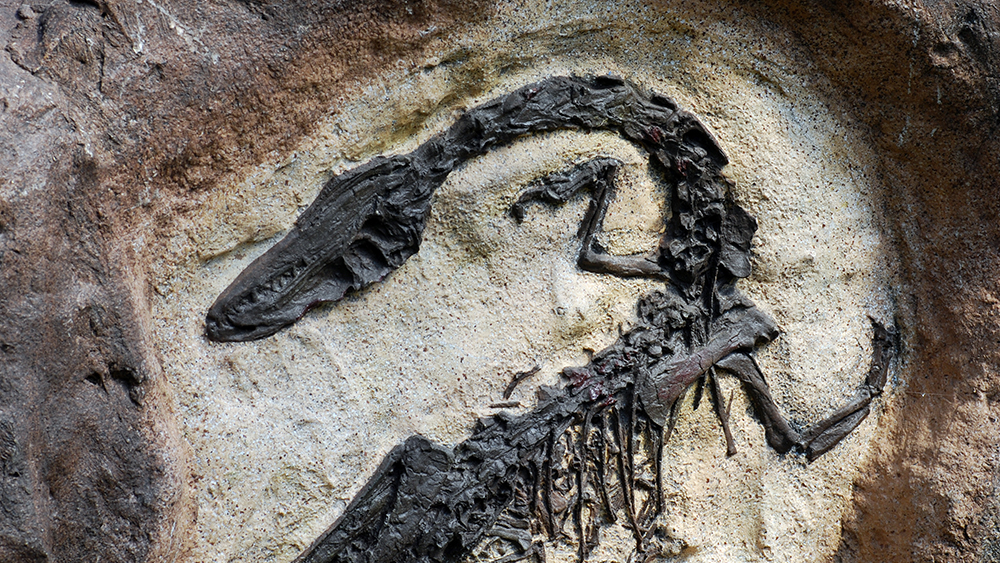A new review paper published in the journal Expert Review of Proteomics summarizes 85 reports of organic remains in fossils.1 Some of the reports describe whole tissues like blood vessels, dried but intact skin, and connective tissues on or inside fossils like dinosaur bones. Other reports describe whole cells like red blood cells and bone cells. Other reports in the review paper describe biochemicals specific to animals (not microbes), including proteins, collagen, elastin, ovalbumin, and keratin. All these reports revealed three trends that call for a vast rethink of the mainstream age of fossils.
The first trend describes a diversity of organic material among different types of fossils. Since the 1960s, researchers have reported on what appear to be original biological material in many fossils allegedly to be millions of years old. These biological remnants occur in dinosaur, bird, mammal, plant, reptile, amphibian, clam, insect and other arthropods, sponge, and worm fossils.
A second trend involves geography. The study authors noted the extent of biomaterials in fossils covers most of Earth. Some researchers even described their results taken from offshore fossils. Literature describes these remnants in fossils from North America, South America, a few in Africa, Europe (including Belgium, UK, and Spain), and Asia (featuring India and China). So far, only Antarctica and Australia lack fresh-looking fossils.
Amino acids found in a tree stump fossil might, if published technically, add Antarctica to the list.2 Australia’s inclusion may just be a matter of investigative time and effort. Thus, this second trend finds that fossil biomaterials span the globe. Shouldn’t a global effect call for a global cause?
Third, the study authors noted extensive geology. Over the last fifty years, hundreds of fossil experts have found specimens that apparently contain original biomaterials from most of the ten iconic geological systems. The researchers tallied a high number of finds from Cretaceous layers, and some reports from Jurassic, Triassic, Pennsylvanian, Silurian, and Cambrian. The most surprising protein remnants were found in layers below the Cambrian. These lowermost strata bear age assignments far older than 500 million years—a clear mismatch with expected protein chemical lifespans.
The review paper noted that biomaterials like proteins always decay over time, and that experiments show that although some might last thousands of years, none should last millions. The study authors therefore had to admit to the ridiculously huge difference between experimental expectations and the actual fossil finds and the dates traditionally ascribed to them. Biomaterial preservation appears not to care about creature kinds, continents, or even rock layers. Organic remains could pop up anywhere one finds fossils. In the end, readers are left to find their own ways to explain these three trends from the 85 scientific reports.
References
1. Thomas, B., and S. Taylor. Proteomes of the Past: The Pursuit of Proteins in Paleontology. Expert Review of Proteomics. Published online before print, December 12, 2019.
2. Pappas, S. 280-Million-Year-Old Fossil Forest Discovered in … Antarctica. LiveScience. Posted on livescience.com November 15, 2017, accessed December 16, 2019.

Eighty-Five Reports of Biological Remnants in Fossils
The Latest
CREATION.LIVE PODCAST
Ask, Seek, and Find with Dr. Brown | Creation.Live Podcast: Episode...
What is truth? Is truth absolute? Is it malleable as sensibilities and cultures shift?
Hosts Trey and Lauren are joined by Dr. Michael Brown to discuss...
The Golden Numbers
Evolutionists theorize that the universe came into being through random means. Fundamentally, randomness lacks symmetry since the very concept of symmetry...
Scientists Question Foundational Big Bang Assumption
In April 2024, some of the world’s leading cosmologists convened at the Royal Society in London to question the cosmological principle—the...
Moroccan Dinosaurs in Marine Rocks, Too
Two recent papers by paleontologist Nicholas Longrich and his colleagues describe some unexpected findings in phosphate mines of northern Morocco.1,2...
CREATION PODCAST
Ernst Haeckel: Evolutionary Huckster | The Creation Podcast:...
Ernst Haeckel, a German Zoologist, is famous for developing a series of images of embryos in development called Anthropogenie. These images,...
Bees Master Complex Tasks Through Social Interaction
Bees are simply incredible.1,2 These little furry fliers challenge the very foundation of Darwinism in many diverse ways.
Bees have been...
The Tail of Man’s Supposed Ancestors
Although it has been known for decades and despite insistence to the contrary from the evolutionary community, man—Homo sapiens—has never...
When Day Meets Night—A Total Success!
The skies cleared above North Texas on Monday, April 8, for a spectacular view of the 2024 Great American Solar Eclipse. Hundreds of guests joined...
The Sun and Moon—Designed for Eclipses
Before discovering thousands of planets in other solar systems, scientists tended to assume that other solar systems would be very similar to our own....
Let ICR Help You Prepare for the Great American Solar Eclipse!
On Monday, April 8th, the moon will move directly between the earth and the sun, resulting in a total solar eclipse visible in northern Mexico, much...















